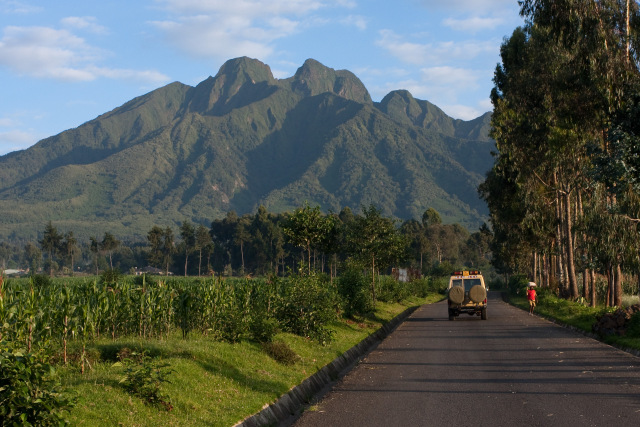Current vulnerability in the Virunga landscape, Rwanda


Volcanic Mountains Rwanda. Image ©Jack Swenson
Project background
Between 2011 and 2012, a regional baseline assessment to analyse vulnerability was conducted in five landscapes of the Congo Basin as part of the ‘Climate Change and Forests in the Congo Basin: Synergies between Adaptation and Mitigation (COBAM)’ project. This briefing note summarises the results for the Virunga landscape around Volcanoes National Park in Rwanda along the borders of Uganda and the Democratic Republic of the Congo (DRC).
Methodology
The vulnerability assessment focused on current vulnerability, which includes an analysis of both past trends and present conditions. In particular, the analysis considers the social aspects of vulnerability, understanding it as a process rooted in the actions of human actors and their interactions with the natural resource base on which they depend.
The methods used to generate information for the various vulnerability dimensions include literature reviews, historical analysis of climate and hazards and, most importantly, participatory workshops. As different groups can display differentiated vulnerability, the analysis was differentiated by gender and by community groups. Workshops were conducted with three groups: one at the district level with local authorities and decision‑makers, and two at the local level gathering communities with different ethnic compositions (Batwa and non‑Batwa groups). For each group, representatives were gathered from all districts adjacent to Volcanoes National Park.
Key messages
The following is a summary of the key outcomes of the project:
1. Local perceptions of change
The inclusion of older people in the participatory exercises made it possible to understand the multiple threats that may have affected the villages in the past, as well as processes of change in terms of coping mechanisms, social dynamics and ecological dynamics. The mass exodus of hundreds of thousands of refugees took its toll on the environment. Conflicts, political and social changes were reported. The re‑establishment of the community justice system – the Gacaca court for crimes committed during the genocide – had many implications for social organisation in communities and indirect impacts on land rights and access. The revision of the matrimonial code, removed many restrictions on women’s access to work and rights to ownership.
2. Differentiated vulnerability
Different climate‑related disturbances affect different groups, natural resources and activities differently. For agricultural activities, the impacts on the soil, plants and on production were differentiated. The results showed that the direct consequences of an event, such as flooding of the fields hampering access and work in the field, can be mitigated, thus leading to smaller final impacts on well-being or income. Problems caused by climatic variability tend to be compounded by mismanagement of arable land. Heavy rains contribute to the degradation of arable lands, but the use of rudimentary cultural techniques is an important factor in erosion. The results show that Batwa groups perceive themselves as being more severely affected by destructive disturbances, such as strong winds, which destroy houses, fields and produce, compared with non‑Batwa groups. Floods also tend to have more severe impacts on agriculture largely because of their poorer access to good‑quality and less exposed land.
3. Dynamics of ecosystems
Volcanoes National Park constitutes almost the only reservoir of forest biodiversity in the area. The restriction on uses imposed by the park limits the interactions between the communities and the forest. Dependency on the park resources is higher for Batwa groups. In particular, 28.8% of the Batwa households stated that they collect fuelwood from the park, compared with only 0.4% of the rest of the community. Nevertheless, exploitation in the park seems to have decreased in recent years because of a reinforced conservation programme and interventions initiated with communities.
4. Current adaptive capacity
The landscape is mainly domesticated and natural forest resources do not make a major contribution to local livelihoods. Most of the safety nets during periods of stress are developed outside the forest through efforts to diversify activities. Infrastructure, land use planning and domestication of the landscape constitute other main responses to the stresses. These initiatives are generally supported by public policies or external actors, mainly development agencies. The gorilla‑based conservation scheme has been a tremendous factor behind economic development in the region and is largely held up as a success story in Africa. Increased devolution of authority to the local level and shifting of responsibility to local communities have contributed towards the strengthening of adaptive capacity in the region. The management of natural resources remains a highly centralised process that is mainly implemented through restriction of access and top‑down regulation (conservation approach, state plantations). However, this approach has failed to prevent uncontrolled exploitation of resources, including park resources, which exacerbates the vulnerability of the population.
Lessons Learnt
1. Possible approaches to improve adaptive capacity include fostering agroforestry and restoring abandoned lands. However, as the shortage of available land prevents the establishment of large plantations, strategies need to be developed for marginal lands, and would then require coordination of multiple individual activities. Possible strategies would be to introduce mechanisms to reduce overexploitation of fuelwood and to encourage transformation and valorisation of residues.
2. Pilot projects, such as those supported by the COBAM project, could lay the foundations for longer‑term solutions, as long as there is systematic learning that enables reflection and refinement along the way. This will require mechanisms to support the learning process and enable experimenting, monitoring and improving over time.
The insights generated through the vulnerability baseline assessment in the Virunga landscape will be combined with more in‑depth research to explore future vulnerability and to identify synergies between mitigation and adaptation in the project sites. Results from further analyses and evaluation of future strategies will be used to generate recommendations to inform decision‑making and planning at local and national levels across countries in the Congo Basin.
(0) Comments
There is no content